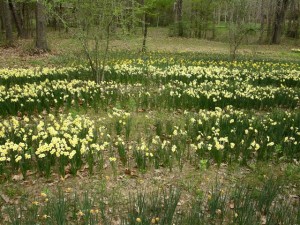If you kept my photos and posts from this past spring about my applying a thin strip of pure nitrogen fertilizer across these rows of daffodils then skipping an area and applying another strip of fertilizer then here is the follow up photos. The gap in these rows (4 feet wide plantings) that you see right in the middle of the photo is the area I did NOT fertilize. Again we often believe that for plants to bloom you do NOT add nitrogen.
Michael Kuduk mentioned that he was thinking about going out and applying 10-10-10 to his short stemmed daffodils. Donna Dietsch followed up that fertilizer would NOT lengthen the stems. I think it would depend on the soil being tested that Michael’s daffodils are being grown in.
Nitrogen creates more leaf growth. The plant leaves then are exposed to the sun and the plants manufacture food during photosynthesis that the plant then moves through out it’s vascular system to feed the rest of the plant. Without leaves and sunlight a plant will starve to death no matter what kind of soil it is growing in.
This area of our land has a PH of 4.5 and according to soil analysis tests this past winter the soil contained only 1 part per million nitrogen in the soil before I added these thin bands of fertilizer.
When looking at the photo notice the height of the blooms and stems on each side of this gap. Notice the color of the foliage and even the weeds that picked up the extra nitrogen to the right and left of the area I skipped.
It is appearing from these photos that a lack of nitrogen in the soil and lack of rainfall this spring would have most of these rows of daffodils that are absorbing their blooms or failing to put up a bloom stalk in the areas where I did not fertilize these Golden Dawn.
AGAIN I am NOT advocating going out willy nilly and tossing fertilizer of ANY kind on your valuable daffodils!!! This area of our property is going to be part of a three year study where we bring up the soil PH to about a 6.2 and slowly bring up the soil micro and macro nutrients more in line with what we think daffodils will thrive in.
It would appear to me that had I NOT added a tiny amount of nitrogen to these strips this year that I would have had little to no bloom as of yesterday. I am going to send a couple more shots and some other thoughts on this experiment. Keith Kridler Mt. Pleasant, Texas


1 comment for “soil infertility and short stems”